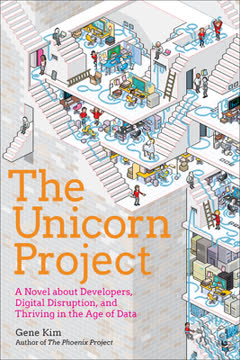Key Takeaways
1. Gamestorming: A new approach to knowledge work and innovation
Gamestorming is about creating game worlds specifically to explore and examine business challenges, to improve collaboration, and to generate novel insights about the way the world works and what kinds of possibilities we might find there.
Shift in work paradigm. The industrial era's focus on standardization and predictability is giving way to a knowledge economy that demands creativity and innovation. Gamestorming offers a framework for navigating this new landscape, providing tools and techniques to tackle complex, ambiguous challenges.
Creating possibility spaces. By designing and playing through "game worlds," teams can explore ideas, test hypotheses, and discover new solutions. These structured yet flexible environments allow for rapid prototyping of concepts and encourage divergent thinking. Gamestorming taps into the power of play to unlock innovation, fostering an atmosphere where failure is low-stakes and breakthrough ideas can emerge.
2. The 10 essentials of gamestorming: Core tools for creative problem-solving
We're entering a new age of discovery where we are exploring a world of information. Like the explorers of the past, we often have only a vague sense of what we are looking for and are not sure what we will find when we get there.
Essential toolkit. The 10 essentials of gamestorming provide a versatile set of methods for navigating complex challenges:
- Opening and Closing
- Fire Starting
- Artifacts
- Node Generation
- Meaningful Space
- Sketching and Model Making
- Randomness, Reversal, and Reframing
- Improvisation
- Selection
- Try Something New
Adaptable techniques. These tools can be combined and reconfigured to suit a wide range of scenarios, from brainstorming sessions to strategic planning. By mastering these essentials, teams develop a shared language for problem-solving and gain the ability to craft custom approaches to unique challenges.
3. Opening, exploring, and closing: The three phases of effective gamestorming
To open is to get people thinking and spark their imaginations. To open you need to create a comfortable environment where people feel invited and welcome so that they will open their minds and explore possibilities they may not have considered before.
Opening: Create a safe, inviting space for idea generation. Use techniques like brainstorming, visual prompts, or provocative questions to stimulate divergent thinking. The goal is to generate a wide range of possibilities without judgment.
Exploring: Dive deeper into promising ideas, combining and refining concepts. This phase involves analysis, prototyping, and testing assumptions. Use games that encourage perspective-shifting, pattern recognition, and collaborative problem-solving.
Closing: Converge on actionable solutions. Employ decision-making tools, prioritization techniques, and consensus-building exercises to align the team on next steps. The closing phase transforms insights into concrete plans.
4. Visual language: Unleashing creativity through simple sketching techniques
Nearly every human endeavor, when examined, reveals evidence of the importance of visual language.
Breaking barriers. Many people believe they "can't draw," but simple visual communication is a learnable skill. The book introduces the "visual alphabet," a set of 12 basic shapes that can be combined to represent any concept.
Power of visual thinking. Sketching and diagramming tap into different cognitive processes than verbal or written communication. By externalizing ideas visually, teams can:
- Identify patterns and relationships more easily
- Communicate complex concepts quickly
- Enhance memory and recall of information
- Foster more engaging and productive discussions
Practical techniques. The book offers exercises to build confidence in visual communication, including methods for drawing people, processes, and abstract concepts. These skills prove invaluable in everything from brainstorming to presenting ideas to stakeholders.
5. Core games: Building blocks for collaborative problem-solving
The 7Ps Framework: Purpose, Product, People, Process, Pitfalls, Prep, Practical Concerns
Versatile toolkit. The core games presented serve as fundamental building blocks for addressing a wide range of challenges. These games can be used individually or combined to create more complex problem-solving sessions.
Key core games:
- Affinity Map: Organize large amounts of information into meaningful clusters
- Empathy Map: Develop deeper understanding of user needs and perspectives
- Forced Ranking: Prioritize options when faced with limited resources
- Post-Up: Generate and organize ideas rapidly in a group setting
- Stakeholder Analysis: Map out key players and their influence on a project or decision
Customization potential. While these core games provide a solid foundation, the book encourages readers to adapt and combine them to suit specific needs. This flexibility allows teams to develop their own unique approaches to problem-solving over time.
6. Games for opening: Sparking creativity and framing challenges
Opening is taking the first step into an empty space. Games that open are focused on framing and describing the bounds of that space and then jumping headfirst into it.
Creating possibility. Opening games are designed to break through mental barriers, encourage divergent thinking, and establish a creative atmosphere. They help teams move beyond obvious solutions and explore new territory.
Key opening games:
- 3-12-3 Brainstorm: Rapid ideation in timed bursts
- The Anti-Problem: Flip the challenge to gain new perspectives
- Cover Story: Envision an ideal future state through storytelling
- Draw the Problem: Visualize challenges to uncover hidden aspects
- Visual Agenda: Set the stage for productive meetings with engaging visuals
Framing the challenge. These games not only generate ideas but also help teams clarify the true nature of the problem they're trying to solve. By approaching challenges from multiple angles, teams often discover that their initial assumptions about the problem were incomplete or misguided.
7. Games for exploring: Navigating complex problems and generating insights
Exploring games make and break patterns. In some cases they ask participants to create forms, and in others they ask them to split them apart.
Deepening understanding. Exploring games help teams dive deeper into problems, uncovering hidden connections and generating novel insights. These games encourage participants to look at challenges from multiple perspectives and challenge assumptions.
Key exploring games:
- 5 Whys: Uncover root causes by repeatedly asking "why"
- Empathy Map: Develop deeper understanding of user needs and perspectives
- Business Model Canvas: Visualize and innovate on business models
- SQUID (Sequential Question and Insight Diagram): Map out complex information spaces
- The World Café: Facilitate large-group discussions on important topics
Pattern recognition. Many exploring games involve organizing and reorganizing information to reveal new patterns and relationships. This process often leads to breakthrough insights that wouldn't be apparent through linear thinking alone.
8. Games for closing: Making decisions and aligning teams for action
Closing is about selecting which opportunities you want to pursue. That means eliminating lines of inquiry that don't seem promising, assigning priorities, and so on.
From ideas to action. Closing games help teams move from the divergent thinking of opening and exploring to convergent thinking focused on decision-making and planning. These games facilitate prioritization, consensus-building, and commitment to next steps.
Key closing games:
- $100 Test: Prioritize options by allocating limited resources
- Impact & Effort Matrix: Evaluate ideas based on potential impact and implementation effort
- Graphic Gameplan: Create visual action plans for projects
- 20/20 Vision: Align teams on priorities and strategic direction
- NUF Test: Quickly evaluate ideas based on Novelty, Usefulness, and Feasibility
Building alignment. Effective closing games not only lead to decisions but also foster a sense of shared ownership and commitment among team members. By involving everyone in the decision-making process, these games increase the likelihood of successful implementation.
Last updated:
FAQ
What's Gamestorming: A Playbook for Innovators, Rule-breakers, and Changemakers about?
- Focus on Innovation: Gamestorming is a guide for teams to generate ideas and solve complex problems through collaborative play, moving away from traditional brainstorming.
- Game Mechanics: It outlines various games and techniques for workshops and meetings to foster creativity and innovation, helping teams explore ideas and develop actionable plans.
- Practical Application: The book provides a comprehensive guide to implementing these games in real-world scenarios, accessible for both novices and experienced practitioners.
Why should I read Gamestorming by Dave Gray?
- Enhance Team Collaboration: The book can significantly improve team collaboration and communication, encouraging participation from all members.
- Boost Creativity: It offers practical tools to unlock creativity and innovation, generating fresh ideas and solutions beyond conventional processes.
- Real-World Examples: Numerous case studies illustrate the effectiveness of gamestorming techniques in various organizational contexts.
What are the key takeaways of Gamestorming?
- Game Design Principles: Understanding game design principles is crucial for effective gamestorming sessions, emphasizing clear goals and interaction rules.
- 10 Essentials for Gamestorming: The book outlines ten essential techniques for any gamestorming session, such as opening and closing, artifacts, and meaningful space.
- Core Games: It provides a catalog of core games for different stages of the creative process, from idea generation to decision-making.
How does Gamestorming define a game?
- Game Space: A game creates an alternative world with specific rules, allowing exploration and experimentation.
- Boundaries and Rules: Defined boundaries in time and space, along with interaction rules, maintain the game's integrity and ensure productive engagement.
- Goal Orientation: A game must have a clear goal, providing direction and purpose to the activities within the game space.
What are the "10 Essentials for Gamestorming"?
- Opening and Closing: Emphasizes starting and ending sessions effectively to manage energy and focus, ensuring engagement and clear outcomes.
- Fire Starting: Techniques to ignite creativity and imagination, helping participants break free from conventional thinking patterns.
- Artifacts: Use of tangible objects to represent ideas and facilitate discussions, making abstract concepts more concrete.
What are some core games mentioned in Gamestorming?
- Affinity Map: Helps teams sort and categorize ideas, visualizing relationships and identifying common themes.
- Bodystorming: A physical approach to brainstorming where participants act out scenarios, encouraging experiential learning and insights.
- Dot Voting: A method for prioritizing ideas by allowing participants to vote on preferred options, helping teams converge on promising concepts.
How can I implement gamestorming in my organization?
- Start Small: Introduce one or two games in team meetings to gauge interest and effectiveness, allowing gradual integration.
- Tailor to Your Needs: Adapt games to fit specific challenges and team dynamics, customizing methods for various contexts.
- Encourage Participation: Foster an environment where all team members feel comfortable contributing, relying on active engagement for success.
What are some best practices for facilitating a gamestorming session?
- Set Clear Objectives: Ensure all participants understand the session's goals, maintaining focus and direction.
- Create a Safe Space: Encourage open communication and idea sharing without judgment, essential for creativity and collaboration.
- Be Flexible: Adapt the session based on feedback and emerging ideas, leading to unexpected insights and breakthroughs.
What is the 5 Whys method in Gamestorming?
- Root Cause Analysis: A technique to explore underlying causes of a problem by repeatedly asking "why" until the root cause is identified.
- Structured Inquiry: Participants write down a problem statement and generate five layers of "why" questions, leading to deeper insights.
- Collaborative Discussion: Encourages group discussion and collaboration, allowing different perspectives to contribute to understanding the issue.
Can you explain the Impact & Effort Matrix from Gamestorming?
- Prioritization Tool: Helps teams evaluate potential actions based on expected impact and effort required.
- Visual Mapping: Ideas are plotted on a 2x2 matrix, identifying high-impact, low-effort actions for prioritization.
- Balanced Decision Making: Encourages weighing benefits and resources needed for each action, promoting balanced decisions.
What is the Wizard of Oz game in Gamestorming?
- Role-Playing Exercise: Involves participants role-playing a machine-human interaction, with one acting as the user and another as the machine.
- Prototyping Interaction: Allows teams to prototype and test interactions in a low-risk environment, uncovering potential issues.
- User-Centric Design: Simulates real user experiences, helping teams understand user needs and refine designs.
What are the best quotes from Gamestorming and what do they mean?
- “Life is full of games...”: Emphasizes playfulness in the creative process, suggesting a gamified mindset leads to enjoyable and effective outcomes.
- “Gamestorming will revolutionize...”: Highlights the transformative potential of gamestorming techniques in enhancing team collaboration and innovation.
- “The point of the game is the play itself...”: Reflects the essence of gamestorming, valuing exploration and discovery over specific outcomes, encouraging creativity.
Review Summary
Gamestorming receives mixed reviews, with an average rating of 3.95 out of 5. Readers appreciate the book's collection of creative techniques for brainstorming and problem-solving in business settings. Many find it a valuable resource for facilitators and teams looking to enhance collaboration and generate innovative ideas. However, some criticize the book for being dry, lacking real-life examples, and containing obvious or repetitive content. Despite these drawbacks, many readers consider it a useful reference guide for improving meetings and workshops.
Similar Books










Download PDF
Download EPUB
.epub digital book format is ideal for reading ebooks on phones, tablets, and e-readers.






